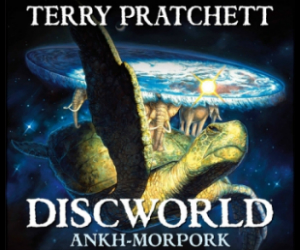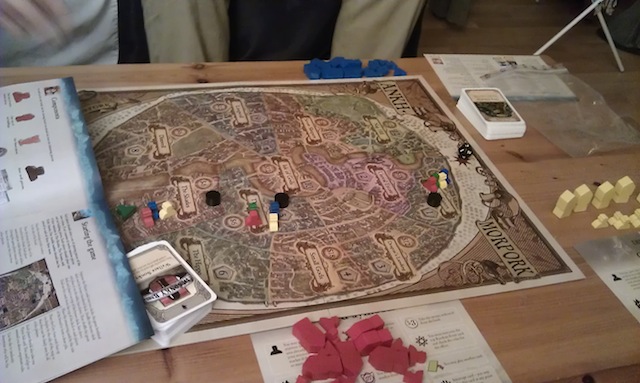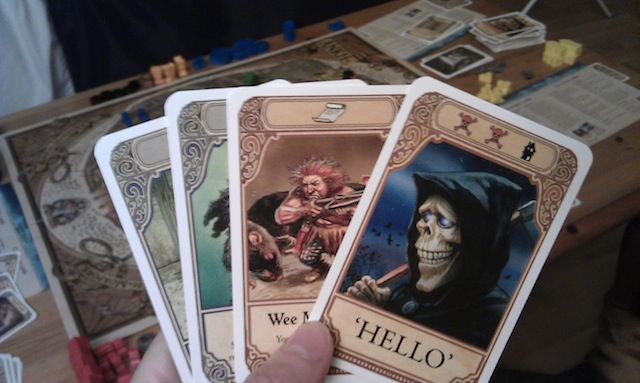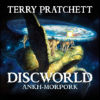 Game: Discworld: Ankh-Morpork
Game: Discworld: Ankh-Morpork
Designer: Martin Wallace
Publisher: Treefrog Games
“Ankh-Morpork! Pearl of cities! This is not a completely accurate description, of course – it was not round and shiny – but even its worst enemies would agree that if you had to liken Ankh-Morpork to anything, then it might as well be a piece of rubbish covered with the diseased secretions of a dying mollusc.” – Terry Pratchett, The Light Fantastic
Much like Star Trek, the works of Terry Pratchett – specifically his Discworld series – have become a nerd culture staple. Indeed, there are few who haven’t read, listened to, seen or, at the very least, heard of one of the Discworld books and, thanks to Pratchett’s excellent writing, it’s rare to encounter someone who says they haven’t enjoyed the experience.
As such, attempting to find a group for this game was pretty easy and, once a number of other nerdy pursuits had been dealt with (read: running a LARP or two), we finally got the chance to sit down and get stuck in to Ankh-Morpork.

The first thing we noticed was how nice the artwork was. The box, board and even the instructions are wonderfully illustrated by a dedicated team of artists overseen by the Discworld Emporium. The latter are presented in a large, well laid out booklet, making it easy for gamers of all experience levels to quickly pick up the basic rules and anything else they might need to know to play. You certainly don’t need to be a hardened board gamer to enjoy Discworld: Ankh-Morpork, and indeed it does identify itself as “a relatively simple game.” However, its simplicity in no way detracts from its fun, especially considering the effortlessly established Discworld flavour that runs throughout the game.
Included with the instructions is the beautiful board, styled as an ornate map of Ankh-Morpork (and, as such, appropriately surrounded by cabbages), various coloured pieces (minions, buildings, demons, trolls and trouble markers), a twelve sided die, some pretty nifty Ankh-Morpork coins (cardboard, before you get too excited), four quick reference cards and a couple of stacks’ worth of random event, personality, city area and player cards. We spent a decent amount of time looking through the cards before playing (perhaps a little too much, but it was totally worth it) and, as a group of Discworld fans, were all pretty pleased with how well each of the places and personalities were represented.
Setting up to play is fairly straightforward. Each player picks a colour and puts one of their minion pieces in The Shades, The Scours and Dolly Sisters. These are also accompanied by a trouble marker, the presence of one of these meaning that you cannot build but are able to assassinate minions should the opportunity arise. A bank is set up, with each player starting with ten Ankh-Morpork dollars, and everyone is dealt a personality card, these (and those remaining) meant to be kept secret until the end of the game (unless you decide to inadvertently flash it to your fellow players mid-game, naming no names). The random event cards are shuffled and placed face down beside the board while the player cards are separated into green and brown bordered decks, the former placed on top of the latter. Five of these are then dealt to each player from the top of the deck, thus forming a starting hand. After the die is used to randomly determine who goes first, the fun starts.

When it’s your turn, you pick one of the cards in your hand to play, following the instructions it gives you. This can involve a variety of things including taking cards or money from another player, discarding cards or even changing your personality card for an entirely new one. In addition to any unique text a particular card might have, each will also have one or more symbols and, depending on what these are, you may:
- Place a minion
- Place a building
- Remove a minion, troll or demon
- Remove a trouble marker
- Take the indicated amount of money from the bank
- Turn over a random event card
- Play another card
Some cards displaying the appropriately named interrupt symbol can also be used at any point in the game, meaning you might be able to pull off a crucially advantageous move outside your own turn.
The game can be won in a number of ways, this is dictated by the victory conditions given on which of the seven personality cards you’re dealt at the start of the game: Vetinari, for example, requires you to have a certain number of minions – this dependent on the number of players – in different areas of the board acting as your spies, while Commander Vimes’s victory condition, which is easily my favourite, comes to pass if nobody else wins by the time the draw pile has been exhausted. The back of the box gives the game time as 60 minutes, but after having got the rules down in hardly any time at all we easily finished the majority of the several games we played in under that time.

VERDICT: Discworld: Ankh-Morpork is both a fun and accessible game, even if you haven’t read the entirety of Terry Pratchett’s collected works from cover to cover. While you may miss a few in-jokes if you haven’t experienced at least a couple of Discworld books, this certainly shouldn’t impact on the enjoyment of what is a solid board game. The group I played with – each member having a varying degree of Pratchett savvy – certainly seemed to enjoy the handful of games we played, it allowing us to indulge in scheming, backstabbery and general strategising all excellently coloured by the Discworld universe. We played with four people, but you can play with three and, with the removal of a few specific cards detailed in the instructions, even two. In short, definitely worth adding to your board game collection. Just remember: Never enter an arsekicking contest with a porcupine.






